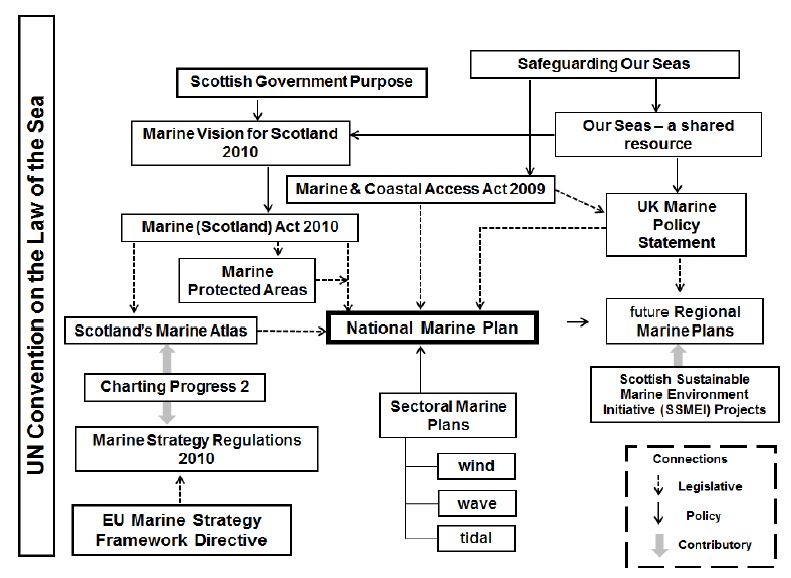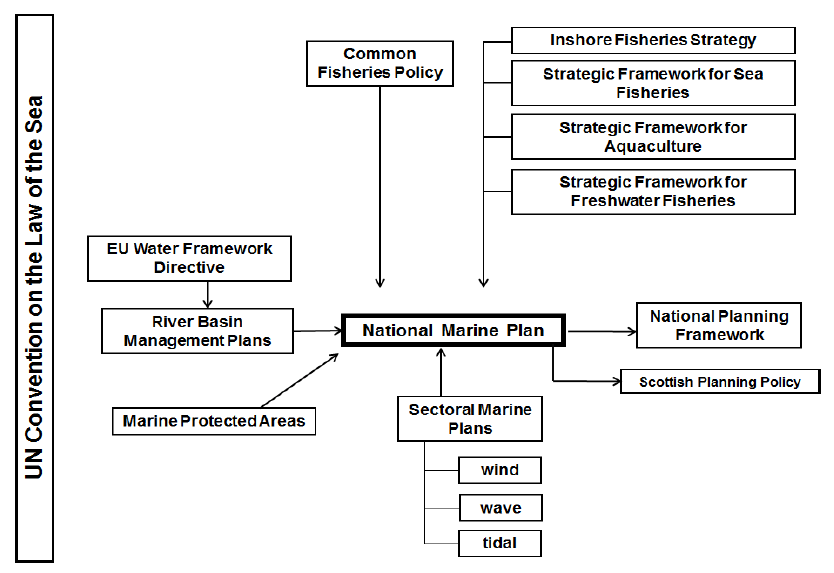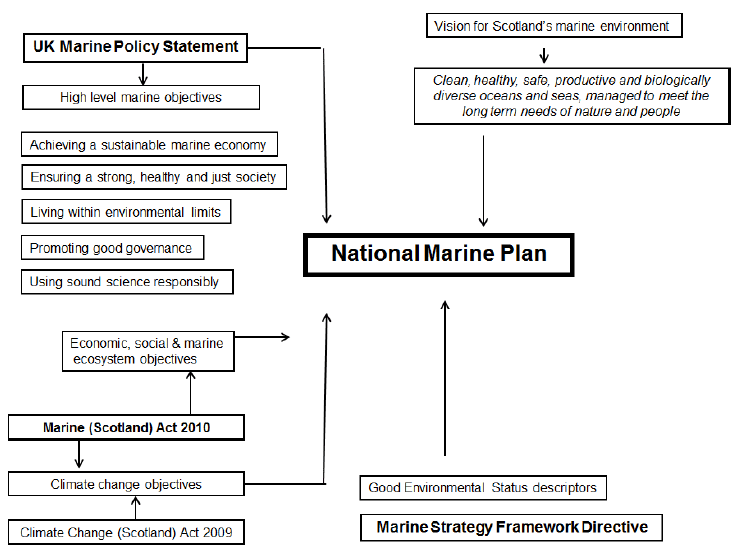National Marine Plan: Sustainability Appraisal Report
This report summarises the findings from a Sustainability Appraisal (SA) of the draft National Marine Plan (NMP). SA of the draft plan is required by the Marine and Coastal Access Act 2009. The SA has considered the potential social, economic and enviro
2.0 National Marine Plan for Scotland
2.01 The NMP brings together existing national-level policy on the marine environment, provides new policy where this is required at the national level, sets the policy framework for regional marine plans and provides direction to marine and terrestrial decision-makers. Table 1 summarises key facts about the draft plan.
2.1 Relationship with other relevant plans, programmes and strategies
Legislative and Policy Context for Plan Preparation
2.1.1 The draft NMP has been prepared in the context of international, European, UK and Scottish marine legislation, policy and guidance (Figure 2). In addition, marine planning sits alongside terrestrial planning policy and other planning and regulatory regimes which together work to manage sustainable development and use of the coastal and marine environment (Figure 3). Further information is provided in the following paragraphs and in Section 2.2.
2.1.2 At the international level, the United Nations Convention of the Law of the Sea establishes the right of coastal nations to set laws and regulate the use of the marine area out to 12 nautical miles. The Convention also establishes exclusive economic zones from 12 to 200 nautical miles from the coast.
2.1.3 At the European level, the Marine Strategy Framework Directive ( MSFD) requires Member States to put measures in place to achieve or maintain good environmental status by 2020 through application of an ecosystem approach to marine management. Member States were required to report on their initial assessment of their seas and to determine good environmental status and associated targets and indicators by 2012 [1] . The Directive is transposed into UK legislation by the Marine Strategy Regulations 2010. [2]
2.1.4 At the UK level, the Marine and Coastal Access Act 2009 requires that marine plans are prepared for the UK marine area (0 to 200 nautical miles). The devolved administrations (the Scottish Government, the Welsh Assembly Government and the Northern Ireland Executive) have jurisdiction over marine planning matters from 0 to 12 nautical miles.
Figure 2. NMP policy context (international, European, UK and Scottish marine legislation and policy )
Figure 3. NMP policy context (terrestrial and other planning/regulatory regimes)
2.1.5 In accordance with this legislation, the UK Government and devolved administrations have prepared a joint Marine Policy Statement ( MPS). The MPS provides the framework for preparing Marine Plans and for decision-making in relation to the marine environment, and establishes policies and objectives for specific sectors and activities. The MPS builds on the UK vision for clean, healthy, safe, productive and biologically diverse oceans and seas [3] and the 'High Level Objectives' for the marine environment agreed amongst the four UK administrations [4] to fulfil this vision.
2.1.6 In Scotland, the legislative and management framework for the marine environment is established by the Marine (Scotland) Act 2010. The Marine (Scotland) Act 2010 builds on the vision established by Marine Scotland [5] , which used the UK vision as a starting point. As previously noted, the Scottish Government has jurisdiction over marine planning matters from 0 to 12 nautical miles. For the purposes of marine planning, the marine area from 12 to 200 nautical miles is executively devolved to the Scottish Ministers. As a result, the draft NMP reflects the legislative provisions outlined in both the Marine (Scotland) Act 2010 and the Marine and Coastal Access Act 2009.
2.1.7 The Marine (Scotland) Act 2010 allows for a system of regional marine planning to be developed for Scottish waters. The regional plans will be directed by the objectives and policies of the National Marine Plan and will draw on existing work undertaken as part of the Scottish Sustainable Marine Environment Initiative ( SSMEI). This initiative comprised a series of local marine planning pilot projects, undertaken with the aim of gaining a greater understanding of the nature, value, and management needs of Scotland 's marine environment [6] .
2.1.8 There are a significant number of policy and legislative drivers at the national, European and international levels that apply to the various sectors which use the marine environment (including transport, shipping, fishing, energy and renewable energy). For example, the International Maritime Organization ( IMO) regulates shipping. These requirements have been taken into account in the draft plan's preparation.
Purpose and Scope of the Plan
2.2.1 As noted in paragraph 2.1.4, preparation of the NMP is a requirement of the Marine (Scotland) Act 2010 (as this applies to Scottish inshore waters) and the Marine and Coastal Access Act 2009 (as this applies to Scottish offshore waters). The purpose of the NMP is to manage increasing demands for the use of Scotland's marine environment, encourage economic development of marine industries and incorporate environmental protection into marine decision making. It also has a role to play in managing mitigation of and adaptation to climate change.
Geographical Scope
2.2.2 The NMP extends from Mean High Water Spring ( MHWS) tide to 200 nautical miles. The powers in the Marine (Scotland) Act 2010 extend from MHWS to the seaward limit of the Scottish inshore waters (12 nautical miles). Executive devolution allows Scottish Minsters to plan for Scotland's seas from 12 to 200 nautical miles.
Temporal Scope
2.2.3 The objectives and policies of the NMP will apply for a period of five years, in accordance with the requirements of Section 16 of the Marine (Scotland) Act 2010. This requires that the effectiveness and progress of the NMP be reviewed and reported on within five years of adoption. The findings of the review will assist the Scottish Ministers in deciding whether there is a need to replace or amend the NMP.
Legislative Scope
2.2.4 The NMP applies to the exercise of both reserved and devolved functions (with the agreement of the UK Secretary of State for reserved functions).
Application of the NMP
2.2.5 The draft NMP has been developed for all users of the sea, including the renewable energy sector, fishing, leisure and recreational users, ports and harbours, aquaculture and transport.
Focus of the NMP
2.2.6 The NMP presumes in favour of sustainable development and use of the marine environment, subject to specific processes such as marine licences, and provides direction on Scottish Ministers' goals for the marine environment. It sets objectives and policies which will direct key activities and assist in resolving conflict where it arises.
Regional Marine Plans
2.2.7 The NMP will guide regional planning. The Scottish Marine Regions will be created under secondary legislation. The Scottish Marine Regions Order 2013 will identify and establish their boundaries and is expected to come into force later in 2013. Regional marine plans will be taken forward by Marine Planning Partnerships.
Sectoral Marine Plans: Renewable Energy
2.2.8 The Sectoral Marine Plan for Offshore Wind in Scottish Territorial Waters will inform the NMP. This sectoral plan is being refreshed alongside the preparation of sectoral plans for wave and tidal energy which, once complete, will also inform the NMP; a linked consultation on the sectoral marine plans will be published alongside this consultation.
Planning Context
2.2.9 The draft NMP sits alongside and interacts with existing land use planning regimes and will be consistent with the national planning policy set out in Scottish Planning Policy and the strategic priorities identified in the National Planning Framework 2 (and the forthcoming National Planning Framework 3). The NMP area physically overlaps with terrestrial planning boundaries to ensure that marine and terrestrial planning together will address the whole of the marine and terrestrial environment.
Table 1. Key facts about the plan
| Responsible Authority |
Marine Scotland |
|---|---|
| Title |
National Marine Plan |
| Purpose |
To manage competing demands for the use of the sea whilst protecting the marine environment. |
| What prompted the plan? |
The Marine (Scotland) Act 2010 introduced a new statutory marine planning framework. Under the 2010 Act, Scottish Ministers must prepare and adopt a national marine plan. |
| Subject |
Marine Spatial Planning |
| Period covered |
2014-2019 |
| Frequency of updates |
The plan is to be reviewed up to 5 years from adoption and updated or replaced if required. |
| Area covered |
Scottish inshore ( MHWS to 12 nautical miles) and offshore waters (12-200 nautical miles) |
| Summary of nature/ content |
The National Marine Plan states Scottish Ministers' policies for the sustainable development of Scotland's seas, including the setting of economic, social and marine ecosystem objectives and objectives relating to climate change mitigation and adaptation. Sector-specific objectives are also identified. |
| Objectives? |
Yes. These are set out in the draft plan and summarised in the SA report. |
| Date |
Summer 2013 |
| Contact |
Marine Scotland NMP team marineplanning@scotland.gsi.gov.uk Telephone: 0131 244 7838 |
Marine Protected Areas
2.2.10 The Marine (Scotland) Act 2010 and the Marine and Coastal Access Act 2009 both contain new powers to designate Marine Protected Areas ( MPAs). These contribute to a range of measures to manage and protect our seas for current and future generations. The legislation also requires that a network of MPAs in UK seas is created to protect biodiversity and geodiversity. The network will contribute to our agreement with international partners to create an ecologically coherent network of well-managed MPAs in the North East Atlantic. The draft NMP takes cognisance of possible MPAs and a linked consultation on the possible nature conservation MPAs will be published alongside this consultation.
Summary of draft NMP contents
2.2.11 The draft NMP contains:
- the vision for the draft plan, set out in Marine Scotland's marine vision and agreed at the UK level (see Figure 4);
- the objectives for the draft plan, based on: the Scottish Government's national objectives; the High Level Marine Objectives; the criteria for 'good environmental status' under the MSFD; and the climate change objectives set out in the relevant legislation [7] ;
- sector-specific objectives; and
- policies.
2.2.12 In terms of policies, the draft NMP is in two parts:
- Part 1 contains general policies, which apply to all decisions made in the marine environment and are relevant to all sectors. These policies implement the strategic objectives (set out in Figure 4) and describe the parameters within which development and activities may take place, ensuring that sustainable economic growth and sustainable development remain a priority so long as they are undertaken in a manner which is sensitive to the environment, other uses and the long-term existence of the resource.
- Part 2 contains sector-specific policies in sectoral chapters. These have been developed where specific policies are required to support the economic growth of a sector, manage conflicts between marine users or manage particular environmental impacts. These policies cover the following sectors:
- Fisheries
- Aquaculture
- Wild salmon and migratory fish
- Oil and gas
- Carbon capture and storage
- Offshore renewable energy
- Recreation and tourism
- Transport: shipping, ports, harbours and ferries
- Telecommunication cables
- Defence
- Aggregates
2.2.13 The wording of the policies is provided in Appendix 3, in the appraisal tables.
Figure 4. NMP objectives
Reasonable alternatives considered
2.2.14 The Environmental Assessment (Scotland) Act 2005 requires that reasonable alternatives to the draft NMP are assessed as part of the SEA. Alternative approaches to the preparation of the draft NMP were considered at the start of and during the marine planning process, and these have been grouped into three tiers of alternatives:
- Do nothing
- Use of alternative approaches:
- A high level strategic plan
- A high level spatial plan
- Use of alternative priorities
- An economically-focused plan
- An environmentally-focused plan
2.2.15 Workshops were held with the Consultation Authorities [8] and key stakeholders in 2011 to discuss the application of alternative priorities, to see what a plan would look like when developed under the different policy drivers (see Section 4 for more details).
2.2.16 Specific alternatives for individual objectives or policies have not been identified. However, in developing the draft NMP, consideration has been given to the weight and level of prescriptive policy developed for the management and use of the marine area and to guide the development of regional marine plans.
2.2.17 In developing planning policies, consideration was given to what type and strength of policy could address key challenges/ issues / objectives, in particular whether the issue:
- can be addressed in an overarching / general safeguarding policy
- needs a more hierarchical approach, e.g. setting out facilities / activities with different levels of importance and therefore greater or lesser degrees of recognition within the licensing process
- needs criteria-based policy, usually providing a framework for the consenting process
- would benefit from a more enabling / aspirational policy
- requires influencing policy, perhaps where the issue overlaps with or goes beyond the scope of the draft NMP
- cannot be resolved nationally and therefore requires a steer for regional plans
- could have a more spatially defined policy, to address known national level issues and/or reflect spatial outputs of other planning processes
2.2.18 Consideration has been given to the weight that the different policies and objectives are afforded within the NMP and the option to set 'decision rules' to support decision-makers and guide the development of marine regional plans. This level of prescriptive policy would require a high degree of information gathering and analysis. It was considered that this option would detract from the key purpose and benefit of regional planning at a local level where local conflicts are better understood.
2.2.19 The revised draft NMP sets out clearer policies within the plan to reflect national priorities and to provide a greater element of guidance. As such the draft NMP provides a national framework within which planning decisions can be taken, and more prescriptive decisions will be taken within regional planning.
2.3 Environmental Protection Objectives
2.3.1 The Environmental Assessment (Scotland) Act 2005 requires responsible authorities to identify the broader policy context and the environmental protection objectives relevant to the plan that is being assessed. The broader policy context is described in Sections 2.1 and 2.2.
2.3.2 Relevant environmental protection objectives are set out in Appendix 2. In summary, the following key environmental protection objectives are of particular relevance to the draft NMP:
- Biodiversity policies range from broad commitments to protection and enhancement of key species and habitats, to objectives that focus specifically on conserving marine ecosystems. The list of habitats and species is lengthy, with marine features accounting for a significant proportion of all protected resources. Particular protection is afforded to migratory birds and cetaceans through international agreements.
- Relevant objectives that support population and human health include those which aim to control bathing water quality. Access legislation and guidance on recreational use are also relevant considerations.
- Objectives relating to the water environment (coastal and marine) aim to reduce pollution and improve the overall water quality and ecological status/potential of coastal and transitional water bodies, as well as controlling other operations such as engineering and coastal flood defences. Issues of relevance to this SA include targets for coastal water quality, and objectives to safeguard marine areas from risks of pollution arising from sea and coastal transport. The Water Framework Directive and the Marine Strategy Framework Directive are also relevant and reflected in the plan.
- Climate-related objectives set targets for greenhouse gas emissions at the international and national levels. Adaptation to climate change is also a key policy element.
- Air quality targets and objectives aim to achieve good ambient air quality. These are supported by national air quality objectives.
- Cultural heritage objectives include commitments to protecting the historic environment whilst increasing understanding and awareness of its value. Key objectives relate to coastal and offshore designated and undesignated buildings, archaeology and wrecks.
- Objectives relating to landscape and seascape reflect the broader framework provided by the European Landscape Convention, which emphasises a broad and inclusive approach to landscape protection and enhancement. The diversity and scenic value of coastal seascapes is included as a key theme in the updated Natural Heritage Futures series produced by SNH.
2.3.3 The environmental protection objectives form the basis for the development of the SA objectives used to structure this assessment ( Section 4).
Contact
There is a problem
Thanks for your feedback


